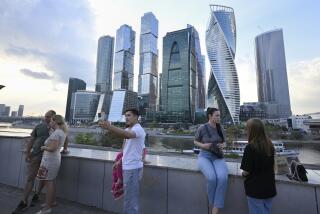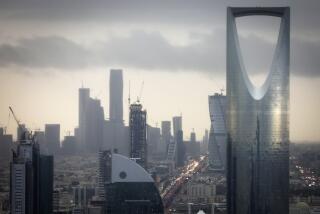Amid oil boom, a new Moscow rises
MOSCOW — For centuries, Red Square and the Kremlin have been the heart of Moscow. But a 21st century downtown is rising, with skyscrapers set to reshape the image of Europe’s largest city.
The $10-billion “Moskva-City” complex of offices, hotels, apartments, restaurants, shops and entertainment centers will have about 25 high-rises, including at least seven buildings taller than any others now existing in Europe. Dominating the site will be the 2,008-foot-tall Russia Tower, which will be one of the tallest buildings in the world and is due for completion in 2012. Most of the rest of the center is to open in 2009 and 2010.
The Empire State Building, by comparison, is 1,454 feet tall, including its lightning rod.
Capital officials have been working on the Moskva-City project since 1990, but few others took it seriously until the turn of the century. Now, fueled by an oil-based boom in Russia’s economy, the 148-acre site is a place of frenzied construction.
“When I started doing this in 1990, Moscow shops had nothing on their counters,” Deputy Mayor Iosif Ordzhonikidze said. “The country lived very poorly. After the breakup of the Soviet Union, hot spots emerged and refugees came to Moscow. In 1991, when I said we will be building this Moskva-City and showed the first drawings, nobody would believe it.”
One purpose of the project is to keep the demand for office space from driving other activities out of central Moscow, said Gennady Sirota, head of the city agency that designed the complex situated on the banks of the Moscow River 2 1/2 miles from the Kremlin.
“Russia is very rapidly getting integrated into the outside world,” Sirota said. “Naturally the living function of the center of the city began gradually to be replaced by office functions . Moscow was faced with the task to create a business center analogous to La Defense in Paris or Canary Wharf in London.”
The site, also known as the Moscow International Business Center, is divided into 20 plots where Russian and foreign investors are putting up buildings designed by their own architects but coordinated with Sirota’s office.
“The design level of the entire complex is very high level. It’s good. It will be much higher level than La Defense or Canary Wharf,” said Frank Williams, a New York-based architect whose firm is working with a Russian firm on the 1,246-foot-tall Mercury City Tower.
The Russia Tower will taper like a pyramid, and some of the other skyscrapers will have curved exteriors or outer walls leaning at an angle. The 712-foot Wedding Palace Tower, a multifunctional building that will provide the service implied by its name, is designed to twist dramatically as it rises.
The Moscow city government will move to the site, which will also boast an aqua park with an indoor beach usable even in the bleakest winters.
“Until 1998, not a single investor believed it was possible,” Ordzhonikidze said. “Now one space plot in the complex costs a minimum of $300 million. So the idea was materialized. Naturally, everybody who took part in it, including myself, feels really great satisfaction.”
The complex, which is expected to draw 500,000 people a day, will have an open plaza roughly the size of Red Square at its center, Ordzhonikidze said. “We’re talking about a huge concentration of people on a bigger scale than at any other place,” he said.
“We tried to create a situation where after 6 p.m., this will not become a dead city like many business centers in the world, where doors get locked, people leave and the buildings stand there dark,” he said. “We wanted our Moskva-City to work nonstop. A big number of shops will be open round-the-clock, and the aqua park will work until late. In summer, the Moscow River will be a transportation route practically the whole night.”
Space in the complex will go roughly 60% for offices, 10% for hotels, 10% for apartments and 20% for shops, restaurants, the aqua park and other entertainment facilities or services. Total floor space will be about 44 million square feet — roughly equivalent to 16 Empire State buildings.
Direct rail lines will link the center with two of Moscow’s airports, with one line due for completion in 2009 and the other in 2010. An eventual link to the third main airport is also planned. “You will be able to come here, check in your luggage, park your car, get through customs, get on the train and end up on the airplane,” Ordzhonikidze said.
An underground tunnel will link the complex to a nearby port on the river. Goods will be unloaded there from barges, railway cars or trucks and loaded onto unpiloted capsules set on rails to be brought through the tunnel, which links to elevators opening in the basements.
There will also be floodlights that can bathe the towers in colors at night.
The high-level design and grand scale of Moskva-City reflects the wealth that Russia enjoys from oil, natural gas and other resources, Williams said.
“The energy of cities goes through cycles,” he said. “This is Moscow’s time.”
More to Read
Sign up for The Wild
We’ll help you find the best places to hike, bike and run, as well as the perfect silent spots for meditation and yoga.
You may occasionally receive promotional content from the Los Angeles Times.






